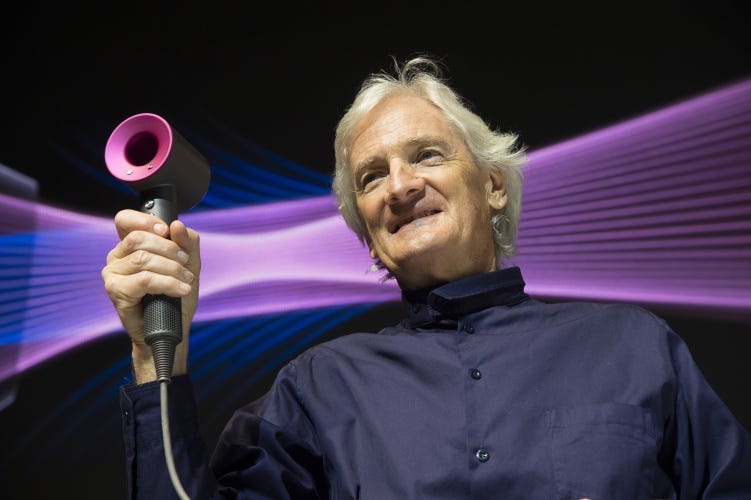Table of Contents
What is James Dyson’s Net Worth?
Sir James Dyson, a British inventor and entrepreneur, has an estimated net worth of $22 billion. His wealth primarily stems from his ownership of Dyson Holdings Pte. Ltd., a company renowned for its high-performance vacuum cleaners, bladeless fans, and hand dryers.
Dyson is known for his invention of the dual cyclone bagless vacuum cleaner, a product that revolutionized the vacuum cleaner market. Despite facing initial resistance from British manufacturers and retailers, who were reluctant to abandon the lucrative market for replacement dust bags, Dyson’s persistence paid off when he successfully launched his product in Japan in the late 1980s. The vacuum cleaner’s success in Japan paved the way for its eventual triumph in the UK and North America, where it became a best-seller.
Beyond vacuum cleaners, Dyson has expanded his product line to include a variety of household appliances, such as hand dryers, hair dryers, and air purifiers. His company reported a revenue of £6.5 billion ($7.8 billion) in the 2022 fiscal year, underscoring the financial success of his ventures.
In addition, Dyson’s wealth is bolstered by his extensive property holdings, including a 300-acre estate in Gloucestershire and significant investments in agricultural land across the UK.
Dyson has been committed to charity work. He established the James Dyson Foundation, which supports design and engineering education, and opened the Dyson Institute of Engineering and Technology to nurture future generations of engineers.
Despite his immense wealth, Dyson remains actively involved in his company’s research and development, continually seeking innovative solutions to modern engineering challenges.
Here’s the breakdown of James Dyson’s net worth:
|
Name: |
James Dyson |
|
Net Worth: |
$22 Billion |
|
Date of Birth: |
May 2, 1947 |
|
Profession: |
Inventor, industrial designer, farmer, and business magnate |
If you’re curious about how we estimate a celebrity’s net worth, you can check out our methodology here.

Early Life and Education
James Dyson was born on May 2, 1947, in Cromer, Norfolk, England. Despite facing financial hardships after his father’s death when he was nine, Dyson received a quality education at Gresham’s School, thanks to a bursary provided by the headmaster. This early educational opportunity laid the foundation for his future success.
Dyson went on to study at the Byam Shaw School of Art from 1965 to 1966, and later at the Royal College of Art from 1966 to 1970, where he transitioned from furniture and interior design to engineering.
Career Beginnings as Inventor
Dyson’s career as an inventor began in the 1970s with his first original invention, the Ballbarrow – a modified wheelbarrow using a ball instead of a wheel.
He continued to experiment with the ball concept, creating the Trolleyball for launching boats and the Wheelboat, capable of traveling at high speeds on both land and water.
Dyson Vacuum Cleaners
The invention of the bagless vacuum cleaner was the turning point in Dyson’s career and the primary source of his substantial net worth. Frustrated with his own vacuum cleaner’s loss of suction, Dyson spent five years and created 5,127 prototypes before perfecting his cyclonic separation technology.
The Dual Cyclone bagless vacuum cleaner, first sold in Japan as the ‘G-Force’ for $2,000, became a status symbol. This success allowed Dyson to establish his own company, Dyson Ltd., in 1991.
The popularity of Dyson vacuum cleaners, particularly after breaking into the UK market with the slogan “say goodbye to the bag,” catapulted the company to become one of the best-selling vacuum cleaner brands globally.
Other Dyson Products
While vacuum cleaners were the initial source of Dyson’s wealth, the company has since diversified into various other product categories, significantly contributing to his net worth.
Dyson has expanded its product line to include bladeless fans, air purifiers, hand dryers, hair dryers, and even attempted to develop an electric car (though this project was eventually cancelled).
The Dyson Airblade hand dryer, launched in 2006, has become commonplace in public restrooms worldwide. The company’s innovative approach to common household appliances has allowed it to command premium prices, further boosting revenues and Dyson’s personal wealth.
In the 2022 fiscal year, Dyson reported a revenue of £6.5 billion ($7.8 billion), underlining the financial success of these diverse product lines.
Research and Development Projects
A significant factor in maintaining and growing Dyson’s net worth is the company’s commitment to research and development. Dyson invests heavily in R&D, with plans to invest £2.75 billion in new technologies and products over five years, as announced in 2020. The company has established research centers globally, including in Singapore, the UK, Philippines, and Malaysia.
In 2023, Dyson announced plans to invest £100 million in a new research and development hub in central Bristol, focusing on software engineering and artificial intelligence.
These ongoing investments in R&D not only help maintain Dyson’s competitive edge in existing markets but also pave the way for future innovations and potential new revenue streams.
James Dyson Foundation
The James Dyson Foundation, established in 2002, plays a significant role in Dyson’s philanthropic efforts. The foundation aims to inspire the next generation of engineers and inventors through various educational initiatives.
Key activities of the foundation include:
- Providing free teaching resources and education programs for teachers and students.
- Offering workshops and after-school programs to encourage hands-on learning in engineering.
- Running the annual James Dyson Award, a global competition that celebrates and supports young problem-solving inventors.
The foundation’s work in promoting engineering education aligns with Dyson’s belief in the importance of nurturing future talent.
Brexit Controversy
James Dyson’s stance on Brexit and subsequent business decisions have been a source of controversy, potentially impacting public perception of his brand.
As a prominent supporter of Brexit, Dyson argued that leaving the EU would bring economic opportunities to British industry. However, his decision to move Dyson’s global headquarters from the UK to Singapore in 2019 drew criticism and accusations of hypocrisy.
This move led to a legal battle when Dyson sued the Daily Mirror publisher over an article that criticized his Brexit support and subsequent relocation. Although Dyson lost this libel claim in December 2023, with the judge ruling that the article represented an honest opinion, the controversy highlights the complex relationship between Dyson’s political views, business decisions, and public image.
Personal Life and Properties
Married to Deirdre Hindmarsh since 1968, Dyson has three children. His personal assets include:
- Dodington Park: A 300-acre Georgian estate in South Gloucestershire, purchased in 2003 for £15 million.
- A house in Chelsea, London.
- Domaine des Rabelles: An estate and winery near Villecroze and Tourtour, Var, France, acquired in 1999.
- Agricultural land: Significant investments in farmland across Lincolnshire, Oxfordshire, and Gloucestershire, making him one of the biggest landowners in the UK.
- Yacht: Dyson owns the vessel Nahlin, one of the largest British-flagged super yachts, with an overall length of 91 meters.
- Private jets: He owns two Gulfstream G650ER private jets (registered G-VIOF and G-GSVI) and previously owned an older Gulfstream G650.
In 2019, Dyson purchased a triplex penthouse in Singapore for £43 million, which he later sold in 2020 for £36 million. As of 2023, Dyson is the beneficial owner of Weybourne Holdings Pte, a Singapore-based business that owns 31 UK properties worth at least £287 million.
These extensive property holdings and luxury assets contribute significantly to Dyson’s overall net worth, estimated at £23 billion according to the Sunday Times Rich List 2023.

Ashley Roberts is the founder of Real-Time Billionaires List. She founded this platform because she likes to know how much celebrities are actually making. She is always curious why these people can make much more money than the ordinary person.
With a Bachelor’s degree in finance, she is skilled at financial analysis and understands numbers related to wealth. Most of the articles on this site are edited by herself before publishing.



